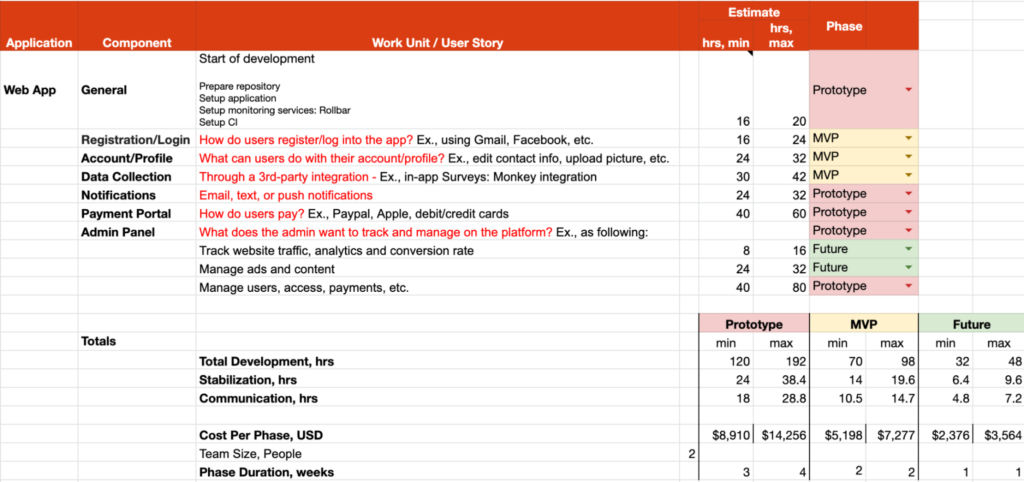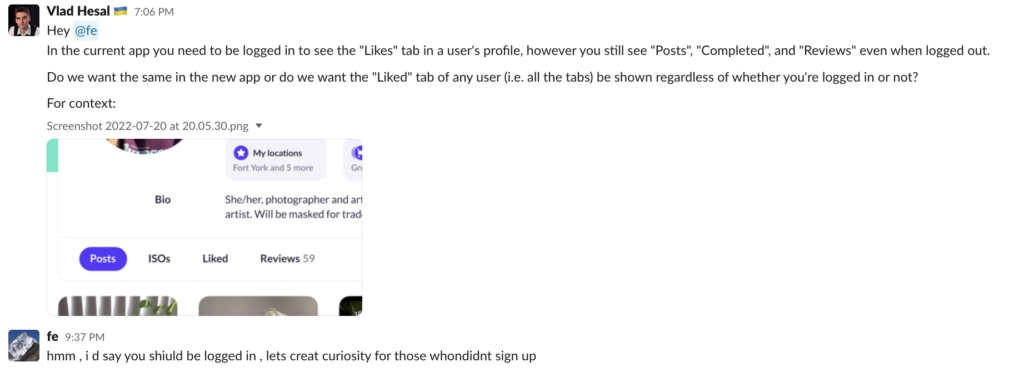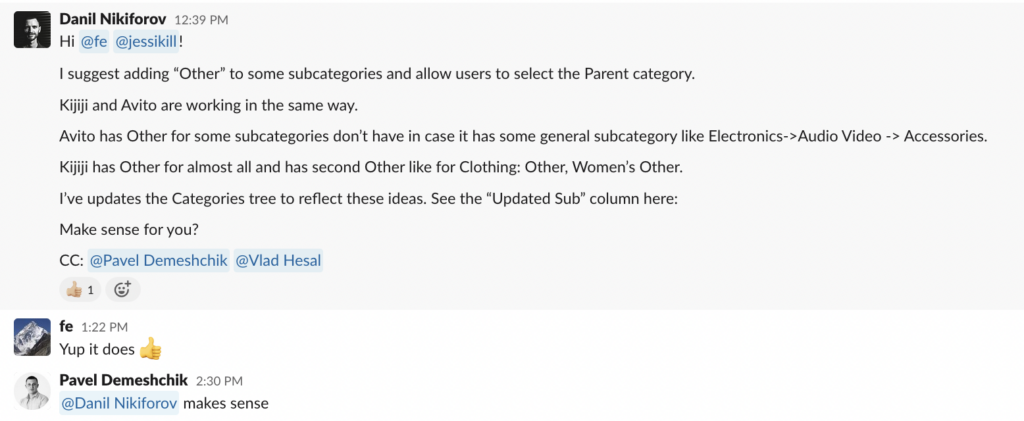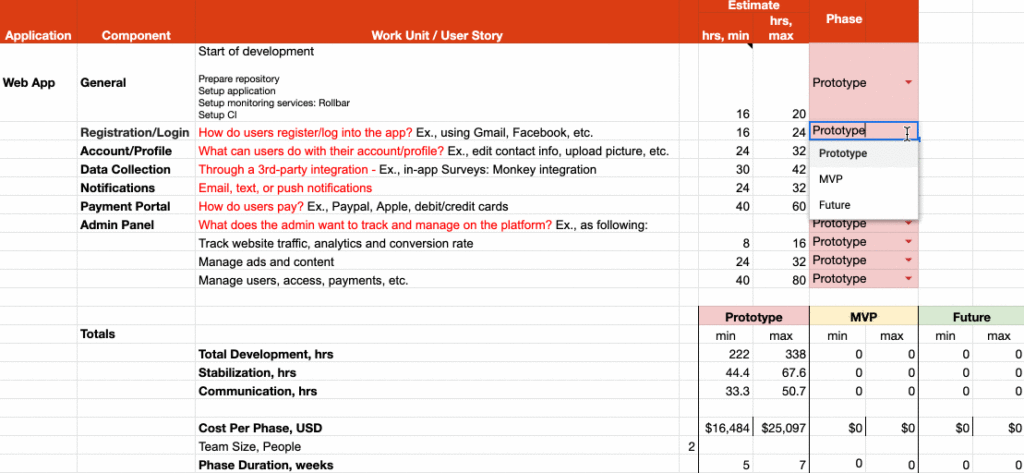
In communication with clients, we’re often asked to prepare an estimate on product development and design services so that they can more accurately allocate money and other resources to a project.
Among various types of approaches, we choose to provide a detailed breakdown estimate. It’s based on the given business requirements, usually clearly defined. Thus, our clients can better see their product’s cost through feature breakdown. Though it still involves uncertainty and the estimated number is likely to change, it can serve as an example for our clients’ consideration and preparation before taking further steps into the development part.
Below, you can find a simplified example of what our detailed breakdown estimate looks like.
The file consists of three components:

We not only provide estimates but also work on the scope to launch MVP with optimal efforts.
When preparing a detailed breakdown estimate, we provide optimistic (minimum number) and pessimistic (maximum number) estimates.
An optimistic estimate describes the best-case scenario when we assume or “hope” everything goes smoothly without obstacles and unexpected risks.
People are optimistic by nature, and software engineers are no exception. We tend to consider the best possible outcome while estimating a project. To avoid biased estimation, our team goes the extra mile and anticipates the estimated number more realistically by preparing a so-called pessimistic estimate.
A pessimistic estimate includes potential risks and unpredicted technical challenges we might encounter during development. In other words, it leaves room and flexibility for tasks that may require different estimates due to certain conditions, including additional adjustments requested by clients. It also allows us to allocate time more properly to research, clarification, testing, and minor fixing.
More importantly, it helps stakeholders estimate financial and timeline risks and align their business goals if the risk is too high.

As clients want to be aware of the approximate delivery time and cost, the optimistic and pessimistic estimate ranges help draw this picture for them. However, any in-advance estimate provided shouldn’t be strictly considered as the final cost. Here’s why.
There is no single project developed exactly as it was originally planned. Once the development process starts and the picture becomes clear, the predetermined priorities are more likely to change. A number of features might be added or removed due to the simplification or complexification needs. Sometimes, product owners completely change their business vectors and pivot the product (and we absolutely encourage that!). Our team always leaves as much room as possible for flexibility and is well-prepared to handle pivots in a product strategy.
If you think you’ve got a flawless plan and it’s not your case, believe us, you might want to reconsider that later 🙂
An estimate helps plan out your resources and be aware of potential costs. However, functional requirements that change over time will definitely impact the previously given estimate. Thus, when a project starts and we get to understand it better, the general estimate is put aside, allowing both parties the flexibility to negotiate every feature individually. It provides the ability to make quick changes and achieve the best possible result in every single situation, keeping in mind the overall deadlines and budgets.
Generally, an estimate is just a prediction of how long the implementation of particular features would take. This would be based on the team’s previous development experience. However, every single system is unique: from new versions of languages and frameworks to different functional requirements.
The worst experience for a client is when the development team delivers an entirely different feature from what was expected. Therefore, when starting a project, our team collaborates and communicates intensively with clients to correctly understand the project’s functional requirements and business goals.

Our team starts off by breaking down a feature into multiple deliverables. It helps to validate a feature before investing more time into it. We then gather user feedback to align it with the client’s vision.
We also discuss various options, propose simplified solutions for feature implementation or come up with completely different ideas to achieve a particular business goal. Although we can’t foresee this in the initial estimate, it can be vital for the eventual success of a project.
As the project continues, our team gradually learns more about the client’s business domain. This helps us realize that some features have been overestimated, whereas others might have been underestimated.
Communication goes both ways. Our clients have a chance to comment and express their views on how a feature should be implemented directly to our development team. At the same time, datarockers are allowed to reconsider the client’s ideas, explain how things work from the development perspective and suggest alternative solutions.

There are projects where the budget and timeline are strictly fixed. What strategy does our team use in this case?
We apply the modern approach called “Fix Time, Fix Budget, and Flex Scope” (FFF). Here are the steps taken from this approach:
Many clients want to have all the features developed, but it doesn’t always happen due to the limited timeline and budget. In this situation, we start building the most crucial functionality and once we reach the deadline/budget limit, we may stop and skip some minor features.
At the estimating stage, we always propose to prioritize the features according to their importance. It often helps to understand the approximate budget and timelines for both an MVP version of the app and a full-featured one.

By applying the FFF approach, we can ensure to have a working version of the product at any time. This benefits both parties.
On the one hand, the team is given opportunities to learn further from what has already been completed. Therefore, we make sure that we are moving in the right direction and are managing the allocated resources properly. On the other hand, the client is given the flexibility to freely change the scope as we progress, if necessary.
Such an approach results in a more efficient collaboration with a client and ultimately a better product.
Although neither the detailed breakdown nor FFF approach estimates provide a final number to strictly rely on, it is particularly useful to have an approximate understanding prior to the project development.
The optimistic (min) and pessimistic (max) estimates create realistic expectations and help clients take possible risks into consideration to better plan costs and resources. The approach works best with bigger projects that imply a lot of uncertainty. The FFF approach, in turn, allows developers to deliver a valuable project under tight deadlines and budgets.
Ultimately, estimation becomes valuable when it helps clients make significant decisions. Our end goal is to deliver projects that help achieve the client’s goals under a given timeline and budget. This always implies intensive negotiation on the Scope of Work, recommendations on possible feature simplification, and better technical implementation of their ideas. In addition, we provide information on potential risks, reasonable timelines, and costs to avoid unrealistic expectations.
If you want to build the project of your dreams with us, submit the form here. We’ve got you covered! 🙂

Check out our newsletter